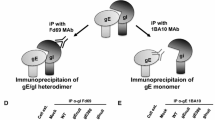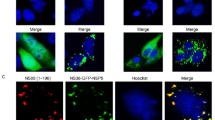Summary
The subcellular localization of the nonstructural protein C of Sendai virus was investigated by means of indirect immunofluorescence microscopy of Sendai virus-infected cells, using an antiserum specific for C protein. In infected cells, C protein was detected exclusively in the cytoplasm as granular fluorescence, which coincided very well with the distribution of nucleocapsid protein NP and phosphoprotein P, which were also detected with specific antisera. This suggested that these proteins are present together in inclusions, probably forming nucleocapsids. In contrast, when the NP and C proteins were individually expressed in COS cells by transfection with expression plasmids containing cDNA for these proteins, their distribution patterns in the cytoplasm were found to be quite different from each other. Protein-blot analyses of purified virions revealed the presence of a significant amount of the C protein in virions, which indicated that C protein is integrated into virions. Under conditions in which most of the envelope-associated proteins, such as HN, F, and M, were removed from the virions by a detergent, the C protein remained tightly associated with the nucleocapsids — about 40 molecules per nucleocapsid.
Similar content being viewed by others
References
Barrett T, Shrimpton SB, Russell SCH (1985) Nucleotide sequence of the entire protein coding region of canine distemper virus polymerase-associated (P) protein mRNA. Virus Res 3: 367–372
Bellini WJ, Englund G, Rozenblatt S, Arnheiter H, Richardson CD (1985) Measles virus P gene codes for two proteins. J Virol 53: 908–919
Burnette WN (1981) “Western blotting”: electrophoretic transfer of proteins from sodium dodecyl sulfate-polyacrylamide gels to unmodified nitrocellulose and radiographic detection with antibody and radioiodinated protein A. Anal Biochem 112: 195–203
Curran JA, Kolakofsky D (1988) Ribosomal initiaion from an ACG codon in the Sendai virus P/C mRNA. EMBO J 7: 245–251
Curran JA, Kolakofsky D (1989) Scanning independent ribosomal initiation of the Sendai virus Y proteins in vitro and in vivo. EMBO J 8: 521–526
Finch JT, Gibbs AJ (1970) Observations on the structure of the nucleocapsids of some paramyxoviruses. J Gen Virol 6: 141–150
Galinski MS, Mink MA, Lambert DM, Wechsler SL, Pons MW (1986) Molecular cloning and sequence analysis of the human parainfluenza 3 virus mRNA encoding the P and C proteins. Virology 155: 46–60
Giorge C, Blumberg BM, Kolakofsky D (1983) Sendai virus contains overlapping genes expressed from a single mRNA. Cell 35: 829–836
Gupta KC, Kingsbury DW (1985) Translational modulation in vitro of a eukaryotic viral mRNA encoding overlapping genes: ribosomal scanning and potential roles of conformational changes in the P/C mRNA of Sendai virus. Biochem Biophys Res Commun 131: 91–97
Hidaka Y, Kanda T, Iwasaki K, Nomoto A, Shioda T, Shibuta H (1984) Nucleotide sequence of a Sendai virus genome region covering the entire M gene and the 3′ proximal 1013 nucleotides of the F gene. Nucleic Acids Res 12: 7965–7973
Itoh N, Yamada H, Kaziro Y, Mizumoto K (1987) Messenger RNA guanylyltransferase fromSaccharomyces cerevisiae. J Biol Chem 262: 1989–1995
Kingsbury DW (1974) The molecular biology of paramyxoviruses. Med Microbiol Immunol 160: 73–83
Kingsbury DW, Hsu CH, Murti K (1978) Intracellular metabolism of Sendai virus nucleocapsids. Virology 91: 86–94
Laemmli UK (1970) Cleavage of structural proteins during the assembly of the head of bacteriophage T4. Nature 227: 680–685
Lamb RA, Mathy BW, Choppin PW (1976) The synthesis of Sendai virus polypeptides in infected cells. Virology 69: 116–131
Lamb RA, Choppin PW (1978) Determination by peptide mapping of the unique polypeptides in Sendai virions and infected cells. Virology 84: 469–478
Luck D,, Sannchez A, Banerjee AK (1986) Messenger RNA encoding the phosphoprotein (P) gene of human parainfluenza 3 is bicistronic. Virology 153: 318–325
O'Farrell PZ, Goodman HM, O'Farrell PH (1977) High resolution two-dimensional electrophoresis of basic as well as acidic proteins. Cell 12: 1133–1142
Omata-Yamada T, Hagiwara K, Katoh K, Yamada H, Iwasaki K (1988) Purification of the Sendai virus nonstructural C protein expressed inE. coli, and preparation of antiserum against C protein. Arch Virol 103: 61–72
Portner A, Gupta KC, Seyer JM, Beachey EH, Kingsbury DW (1986/87) Localization and characterization of Sendai virus nontructural C and C′ proteins by antibodies against synthetic peptides. Virus Res 6: 109–121
Ryan KW, Kingsbury DW (1988) Carboxy-terminal region of Sendai virus P protein is required for binding to viral nucleocapsids. Virology 167: 106–112
Sakai Y, Suzu S, Shioda T, Shibuta H (1987) Nucleotide sequence of bovine parainfluenza 3 virus genome: its 3′ end and the genes of NP, P, C, and M proteins. Nucleic Acids Res 15: 2927–2944
Shibuta H, Akami M, Matsumoto M (1971) Plaque formation by Sendai virus of parainfluenza virus group, type 1 on monkey, calf kidney and chick embryo cell monolayers. Japan J Microbiol 23: 175–183
Shibuta H, Kanda T, Adachi A, Yogo Y (1979) Characterization of bovine parainfluenza virus type 3. Microbiol Immunol 23: 617–628
Shioda T, Hidaka Y, Kanda T, Shibuta H, Nomoto A, Iwasaki K (1983) Sequence of 3,687 nucleotides from the 3′ end of Sendai virus genome RNA and the predicted amino acid sequence of viral NP, P, and C proteins. Nucleic Acids Res 11: 7317–7330
Shioda T, Iwasaki K, Shibuta H (1986) Determination of the complete nucleotide sequence of the Sendai virus genome RNA and the predicted amino acids sequences of the F, HN, and L proteins. Nucleic Acids Res 14: 1545–1563
Taira H, Kanda T, Omata T, Shibuta H, Kawakita M, Iwasaki K (1987) Interferon induction by transfection of Sendai virus C gene cDNA. J Virol 61: 625–628
Tashiro M, Homma M (1983) Pneumotropism of Sendai virus in relation to protease-mediated activation in mouse lungs. Infect Immun 39: 879–888
Thomas SM, Lamb RA, Paterson RG (1988) Two mRNAs that differ by two non-templated nucleotides encode the amino coterminal proteins P and V of the paramyxovirus SV5. Cell 54: 891–902
Author information
Authors and Affiliations
Rights and permissions
About this article
Cite this article
Yamada, H., Hayata, S., Omata-Yamada, T. et al. Association of the Sendai virus C protein with nucleocapsids. Archives of Virology 113, 245–253 (1990). https://doi.org/10.1007/BF01316677
Received:
Accepted:
Issue Date:
DOI: https://doi.org/10.1007/BF01316677




